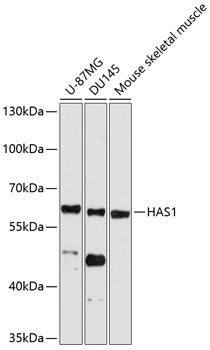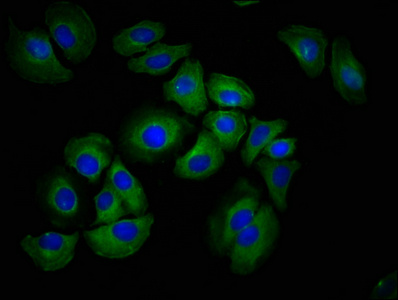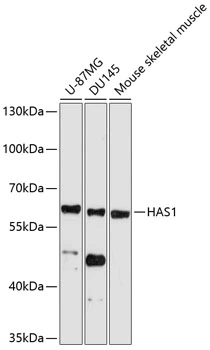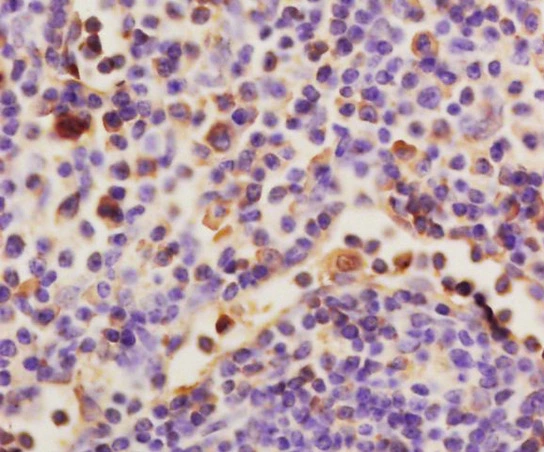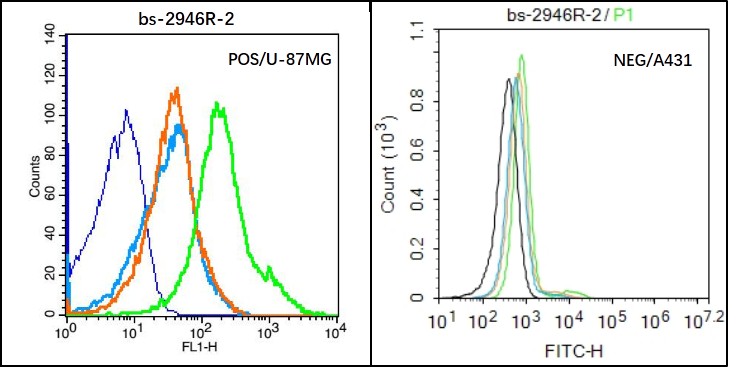![ICC/IF analysis of U251 cells using GTX82799 HAS1 antibody [3E10]. Green : HAS1 Blue: DRAQ5 fluorescent DNA dye Red: Actin filaments ICC/IF analysis of U251 cells using GTX82799 HAS1 antibody [3E10]. Green : HAS1 Blue: DRAQ5 fluorescent DNA dye Red: Actin filaments](https://www.genetex.com/upload/website/prouct_img/normal/GTX82799/GTX82799_20170912_ICCIF_w_23061322_792.webp)
ICC/IF analysis of U251 cells using GTX82799 HAS1 antibody [3E10]. Green : HAS1 Blue: DRAQ5 fluorescent DNA dye Red: Actin filaments
HAS1 antibody [3E10]
GTX82799
ApplicationsImmunoFluorescence, Western Blot, ELISA, ImmunoCytoChemistry, ImmunoHistoChemistry, ImmunoHistoChemistry Paraffin
Product group Antibodies
TargetHAS1
Overview
- SupplierGeneTex
- Product NameHAS1 antibody [3E10]
- Delivery Days Customer9
- Application Supplier NoteWB: 1/500 - 1/2000. ICC/IF: 1/200 - 1/1000. ELISA: 1/10000. *Optimal dilutions/concentrations should be determined by the researcher.Not tested in other applications.
- ApplicationsImmunoFluorescence, Western Blot, ELISA, ImmunoCytoChemistry, ImmunoHistoChemistry, ImmunoHistoChemistry Paraffin
- CertificationResearch Use Only
- ClonalityMonoclonal
- ConjugateUnconjugated
- Gene ID3036
- Target nameHAS1
- Target descriptionhyaluronan synthase 1
- Target synonymsHA synthase 1; HAS; hyaluronan synthase 1; hyaluronate synthase 1; hyaluronic acid synthase 1
- HostMouse
- IsotypeIgG1
- Protein IDQ92839
- Protein NameHyaluronan synthase 1
- Scientific DescriptionHyaluronan or hyaluronic acid (HA) is a high molecular weight unbranched polysaccharide synthesized by a wide variety of organisms from bacteria to mammals, and is a constituent of the extracellular matrix. It consists of alternating glucuronic acid and N-acetylglucosamine residues that are linked by beta-1-3 and beta-1-4 glycosidic bonds. HA is synthesized by membrane-bound synthase at the inner surface of the plasma membrane, and the chains are extruded through pore-like structures into the extracellular space. It serves a variety of functions, including space filling, lubrication of joints, and provision of a matrix through which cells can migrate. HA is actively produced during wound healing and tissue repair to provide a framework for ingrowth of blood vessels and fibroblasts. Changes in the serum concentration of HA are associated with inflammatory and degenerative arthropathies such as rheumatoid arthritis. In addition, the interaction of HA with the leukocyte receptor CD44 is important in tissue-specific homing by leukocytes, and overexpression of HA receptors has been correlated with tumor metastasis. HAS1 is a member of the newly identified vertebrate gene family encoding putative hyaluronan synthases, and its amino acid sequence shows significant homology to the hasA gene product of Streptococcus pyogenes, a glycosaminoglycan synthetase (DG42) from Xenopus laevis, and a recently described murine hyaluronan synthase. Alternative splicing results in multiple transcript variants. [provided by RefSeq, Jul 2014]
- Storage Instruction-20°C or -80°C,2°C to 8°C
- UNSPSC12352203
References
- Adipose-derived mesenchymal stem cells differentiate into pancreatic cancer-associated fibroblasts in vitro. Miyazaki Y et al., 2020 Nov, FEBS Open BioRead more

![WB analysis of human HAS1 (AA: 74-243) recombinant protein using GTX82799 HAS1 antibody [3E10]. WB analysis of human HAS1 (AA: 74-243) recombinant protein using GTX82799 HAS1 antibody [3E10].](https://www.genetex.com/upload/website/prouct_img/normal/GTX82799/GTX82799_20170912_WB_w_23061322_124.webp)
